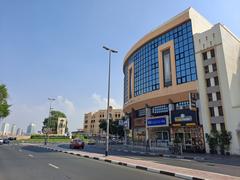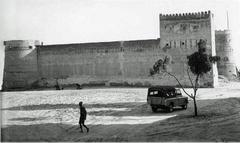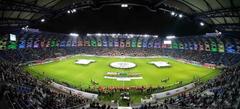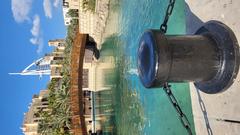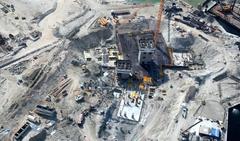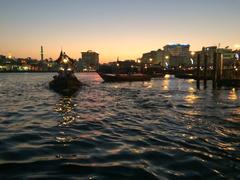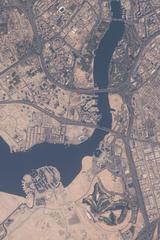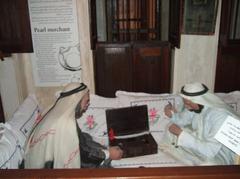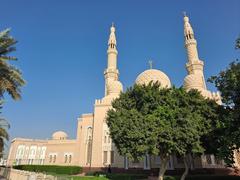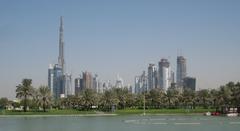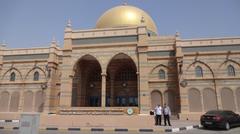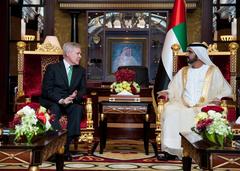Comprehensive Guide to Visiting Al Noor Mosque, Dubai, United Arab Emirates
Date: 18/07/2024
Introduction
مسجد النور, also known as Al Noor Mosque, is a magnificent example of modern Islamic architecture and cultural heritage in Dubai, United Arab Emirates. Completed in 2014, this mosque serves as a place of worship for the local Muslim community and stands as a beacon of spiritual enlightenment and cultural inclusivity. Reflecting Dubai’s rapid development and commitment to preserving Islamic traditions, مسجد النور seamlessly blends traditional Islamic motifs with contemporary design elements. The mosque’s name, ‘Al Noor,’ which translates to ‘The Light,’ symbolizes the spiritual guidance and enlightenment it provides to its visitors. This guide delves into the history, architectural marvels, cultural significance, and visitor information to help you make the most of your visit to this iconic landmark. For those planning to explore Dubai, مسجد النور offers a unique opportunity to experience the city’s rich cultural and religious heritage, making it a must-visit destination (Visit Dubai).
Table of Contents
- Introduction
- History of مسجد النور
- Architectural Design
- Cultural and Religious Significance
- Community Engagement and Outreach
- Preservation and Maintenance
- Visitor Information
- Nearby Attractions
- FAQ
- Conclusion
History of مسجد النور
Origins and Construction
مسجد النور was completed in 2014, reflecting Dubai’s ongoing commitment to expanding its religious and cultural infrastructure. The construction was part of a broader initiative to provide more worship spaces for the rapidly growing Muslim population in Dubai. Funded by private donations and contributions from the local community, the mosque showcases the collective effort to create a space for spiritual and communal gatherings.
Architectural Design
Design Philosophy
The architectural design of مسجد النور is a blend of traditional Islamic elements and modern aesthetics. The mosque features a large central dome, smaller domes, and two towering minarets visible from a distance. The exterior is adorned with intricate geometric patterns and calligraphy, hallmarks of Islamic art. The use of white marble and other high-quality materials enhances the mosque’s visual appeal and ensures its durability in Dubai’s harsh climate.
Exterior Architecture
The exterior of مسجد النور is characterized by its grand dome and minarets, quintessential features of Islamic architecture. The mosque’s facade is adorned with intricate arabesque patterns and calligraphy, showcasing verses from the Quran. The use of white marble and sandstone gives the mosque a pristine and majestic appearance, especially when illuminated at night.
Dome
The central dome of مسجد النور symbolizes the vault of heaven. The dome is intricately decorated with geometric patterns and Quranic inscriptions. The use of muqarnas, a form of ornamented vaulting, adds to the dome’s visual complexity and beauty. The dome’s height and diameter are designed to create a sense of grandeur and awe.
Minarets
The mosque features two towering minarets, each standing at approximately 70 meters. The minarets are not only architectural marvels but also serve a functional purpose as they are used for the call to prayer (adhan). The minarets are adorned with intricate carvings and are topped with crescent moons, a symbol of Islam.
Interior Architecture
The interior of مسجد النور is equally impressive, with a spacious prayer hall that can accommodate up to 1,200 worshippers. The hall is illuminated by large chandeliers and natural light filtering through stained glass windows, creating a serene atmosphere. The mihrab (prayer niche) and minbar (pulpit) are intricately designed, serving as focal points during prayers and sermons.
Prayer Hall
The main prayer hall is a vast, open space designed to accommodate a large number of worshippers. The hall is adorned with plush carpets, chandeliers, and intricate wall decorations. The use of natural light, filtered through stained glass windows, creates a serene and peaceful atmosphere. The prayer hall’s acoustics are carefully designed to ensure that the imam’s voice can be heard clearly throughout the space.
Mihrab and Minbar
The mihrab, a niche in the wall indicating the direction of Mecca, is a focal point of the mosque’s interior. It is beautifully decorated with mosaic tiles and calligraphy. The minbar, a pulpit from which the imam delivers sermons, is located next to the mihrab. The minbar is often made of wood or marble and is intricately carved with Islamic motifs.
Decorative Elements
The decorative elements of مسجد النور are a testament to the rich artistic heritage of Islamic culture. The mosque features a variety of decorative techniques, including calligraphy, geometric patterns, and arabesques.
Calligraphy
Islamic calligraphy is a prominent feature of مسجد النور’s architecture. Verses from the Quran are inscribed on the walls, domes, and arches of the mosque. The calligraphy is often done in a variety of scripts, including Kufic and Naskh, and is considered a form of devotional art.
Geometric Patterns
Geometric patterns are a hallmark of Islamic art and are used extensively in the design of مسجد النور. These patterns, which include stars, polygons, and interlacing designs, are not only aesthetically pleasing but also carry symbolic meanings. The use of geometry in the mosque’s design reflects the Islamic belief in the order and harmony of the universe.
Arabesques
Arabesques, or intricate floral and vegetal designs, are another key decorative element of the mosque. These designs are often used in combination with geometric patterns and calligraphy to create a cohesive and visually stunning interior. The arabesques are meticulously crafted, showcasing the skill and artistry of the craftsmen.
Materials and Techniques
The construction of مسجد النور involves the use of high-quality materials and traditional building techniques. The mosque’s structure is primarily made of reinforced concrete, with exterior cladding of white marble and sandstone. The interior features a combination of marble, wood, and mosaic tiles.
Marble and Stone
The use of marble and stone in the construction of مسجد النور adds to its durability and aesthetic appeal. The white marble used for the exterior cladding is sourced from quarries in Italy and Greece, known for their high-quality stone. The sandstone, used for decorative elements, is sourced locally and adds a touch of regional character to the mosque.
Woodwork
Woodwork is an important aspect of the mosque’s interior design. The minbar, doors, and window frames are often made of high-quality wood, such as teak or cedar. The wood is intricately carved with Islamic motifs, adding to the overall beauty of the mosque.
Mosaic Tiles
Mosaic tiles are used extensively in the decoration of مسجد النور. These tiles are often hand-crafted and feature intricate designs and vibrant colors. The use of mosaic tiles in the mihrab, domes, and walls adds a touch of elegance and sophistication to the mosque’s interior.
Lighting
Lighting plays a crucial role in enhancing the architectural features of مسجد النور. The mosque uses a combination of natural and artificial lighting to create a serene and inviting atmosphere.
Natural Light
Natural light is an important element in the design of مسجد النور. The mosque features large windows with stained glass, which allow natural light to filter into the prayer hall. The use of stained glass not only adds a decorative element but also creates a play of light and color within the mosque.
Chandeliers
Chandeliers are a prominent feature of the mosque’s interior lighting. These chandeliers are often made of crystal or glass and are intricately designed to complement the mosque’s overall aesthetic. The chandeliers provide ample lighting for the prayer hall and add a touch of grandeur to the interior.
Cultural and Religious Significance
مسجد النور holds significant cultural and religious importance for the local Muslim community. It serves as a place for daily prayers, Friday congregational prayers, and special religious events such as Ramadan and Eid celebrations. The mosque also hosts various educational programs, including Quranic studies, Arabic language classes, and lectures on Islamic theology and jurisprudence, fostering a deeper understanding of Islam and promoting community cohesion.
The mosque’s name, “Al Noor,” meaning “The Light” in Arabic, symbolizes the spiritual enlightenment and guidance it provides to worshippers. It is not only a place of worship but also a center for social and cultural activities, reflecting the integral role that mosques play in Muslim communities.
Community Engagement and Outreach
مسجد النور is actively involved in community engagement and outreach initiatives. The mosque regularly organizes charity drives, food distribution programs, and health camps, benefiting both Muslim and non-Muslim residents of Dubai. These initiatives align with the Islamic principles of charity (sadaqah) and social responsibility, emphasizing the importance of helping those in need.
The mosque also participates in interfaith dialogues and events, promoting mutual understanding and respect among different religious communities. These efforts are particularly important in a multicultural city like Dubai, where people from diverse backgrounds live and work together. By fostering a spirit of inclusivity and cooperation, مسجد النور contributes to the social harmony and cultural richness of the city.
Preservation and Maintenance
Given its architectural and cultural significance, مسجد النور is meticulously maintained to preserve its beauty and functionality. Regular maintenance work includes cleaning, repairs, and restoration of the mosque’s intricate designs and structures. The mosque management ensures that the facilities are accessible and comfortable for worshippers, including provisions for ablution (wudu) areas, prayer mats, and air conditioning.
The mosque’s management is committed to sustainability and environmental stewardship. Efforts are made to minimize the mosque’s carbon footprint through energy-efficient lighting, water conservation measures, and waste reduction practices. These initiatives align with the broader goals of sustainable development and environmental protection in Dubai.
Visitor Information
Ticket Prices and Opening Hours
مسجد النور is open to non-Muslim visitors during designated hours. There is no admission fee, but donations are welcome. The mosque is typically open from 9 AM to 5 PM, except during prayer times. Visitors are encouraged to check the official website for the most up-to-date information on visiting hours.
Travel Tips
Visitors should dress modestly, covering their arms and legs. Women are also required to cover their hair. Shoes must be removed before entering the prayer hall. It is advisable to visit in the morning or late afternoon to avoid the midday heat.
Guided Tours and Special Events
Guided tours are available, providing insights into the mosque’s history, design, and significance. These tours are a great way to learn about Islamic practices and traditions. The mosque also hosts special events during Ramadan and Eid, which are open to the public.
Photographic Spots
The mosque’s stunning architecture and serene ambiance make it a popular destination for photographers and cultural enthusiasts. Visitors are welcome to take photos, but they should be respectful of worshippers and avoid taking pictures during prayer times.
Nearby Attractions
The mosque is located near several other attractions in Dubai, including the Dubai Museum, Al Fahidi Historical Neighborhood, and the Dubai Creek. Visitors can easily combine a visit to the mosque with these nearby sites to get a fuller experience of Dubai’s cultural heritage.
FAQ
What are the visiting hours for مسجد النور?
The mosque is open from 9 AM to 5 PM, except during prayer times. It is advisable to check the official website for the most up-to-date information.
Is there an admission fee?
There is no admission fee for visiting مسجد النور, but donations are welcome.
Are guided tours available?
Yes, guided tours are available and provide valuable insights into the mosque’s history and significance.
What should I wear when visiting?
Visitors should dress modestly, covering arms and legs. Women should also cover their hair.
Conclusion
مسجد النور stands as a beacon of faith, culture, and community in Dubai. Its rich history, stunning architecture, and active engagement in social and cultural initiatives make it a significant landmark in the city. Whether you are a worshipper, a student of Islamic culture, or a curious traveler, a visit to مسجد النور promises to be a memorable and enriching experience. For more updates, download the mobile app Audiala, check out other related posts, or follow us on social media (Dubai Tourism).
